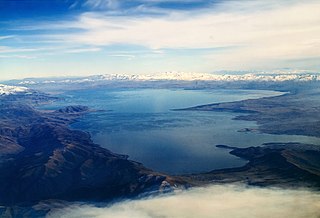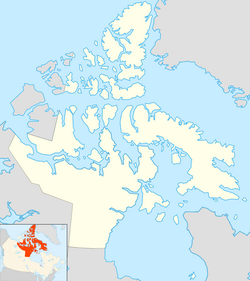
The Tłı̨chǫ people, sometimes spelled Tlicho and also known as the Dogrib, are a Dene First Nations people of the Athabaskan-speaking ethnolinguistic group living in the Northwest Territories, Canada. The name Dogrib is an English adaptation of their own name, Tłı̨chǫ Done - “Dog-Flank People”, referring to their fabled descent from a supernatural dog-man. Like their Dene neighbours they called themselves oft simply Done or Done Do. The Tłı̨chǫ's land is known as Ndé. On the 1682 Franquelin map, Dogrib was recorded as "Alimousp[i]goiak".

Fort Smith is a town in the South Slave Region of the Northwest Territories (NWT), Canada. It is located in the southeastern portion of the Northwest Territories, on the Slave River and adjacent to the Northwest Territories/Alberta border.

Fort Resolution is a hamlet in the South Slave Region of the Northwest Territories, Canada. The community is situated at the mouth of the Slave River, on the shores of Great Slave Lake, and at the end of the Fort Resolution Highway.
Matonabbee was a Chipewyan hunter and leader he also was a trader and was a Chipewyan representative at the prince of whales fort. He travelled with Chief Akaitcho's older brother, Keskarrah. After his father died, Matonabbee spent some time living at Prince of Wales Fort where he learned to speak English.

Dettah or Detah is a First Nations community in the North Slave Region of the Northwest Territories, Canada. Located just outside the capital of Yellowknife, it is a 6.5 km (4.0 mi) drive from that town by ice road in winter or a 27 km (17 mi) drive via the Ingraham Trail. The name means 'Burnt Point' in the Tli Cho language and refers to a traditional fishing camp used by the Dene for hundreds of years.
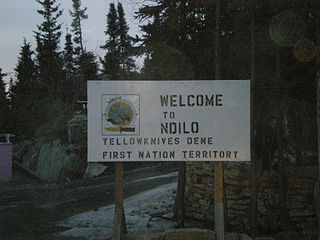
Ndilǫ is a First Nations community in the North Slave Region of the Northwest Territories, Canada. The small Dene community is located on the edge of Yellowknife on the tip of Latham Island. It has a population of approximately 200 people. Ndilǫ and Dettah are the communities of the Yellowknives. Ndilǫ is represented by the Yellowknives Dene First Nation (Ndilǫ) and are part of the Akaitcho Territory Government.

McLeod Lake is an unincorporated community located on Highway 97 in northern British Columbia, Canada, 140 km (87 mi) north of Prince George. It is notable for being the first continuously inhabited European settlement established west of the Rocky Mountains in present-day Canada.

Behchokǫ̀ ([bɛ́ht͡ʃʰókʰõ̀] or [bɛ́ht͡sʰókʰõ̀], officially the Tłı̨chǫ Community Government of Behchokǫ̀, is a community in the North Slave Region of the Northwest Territories, Canada. Behchokǫ̀ is located on the Yellowknife Highway, on the northwest tip of Great Slave Lake, approximately 110 km northwest of Yellowknife.

Łutselkʼe, also spelt Łutsel Kʼe, is a "designated authority" in the North Slave Region of the Northwest Territories, Canada. The community is located on the south shore near the eastern end of Great Slave Lake and until 1 July 1992, it was known as Snowdrift, as the community lies near the mouth of the Snowdrift River.
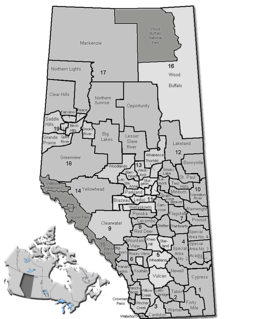
The County of Northern Lights is a municipal district in northwest Alberta, Canada. Located in Census Division 17, its municipal office is located in the Town of Manning.

The Akaitcho Territory Government is a First Nations organization representing the Dene people of the Northwest Territories, Canada.

Cadotte Lake is an unincorporated community in northern Alberta, Canada within Northern Sunrise County. It is located on the northern shore of the homonymous lake, along Highway 986, 79 km (49 mi) east of Peace River and 68 km (42 mi) west of the Bicentennial Highway.

Sachigo Lake First Nation is an Oji-Cree First Nation band government in Unorganized Kenora District in Northwestern Ontario, Canada. It is located on Sachigo Lake, part of the Sachigo River system and Hudson Bay drainage basin, approximately 425 kilometres (264 mi) north of the town of Sioux Lookout. As of September 2011, the First Nation had a registered population of 814 people, of which the on-reserve population was 443.
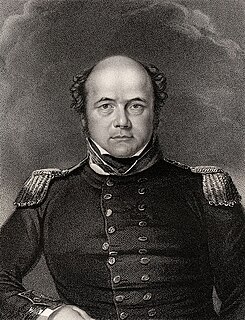
The Coppermine expedition was British a overland undertaking to survey and chart the area from Hudson Bay to the north coast of Canada, eastwards from the mouth of the Coppermine River. The expedition was organised by the Royal Navy as part of its attempt to discover and map the Northwest Passage. It was the first of three Arctic expeditions to be led by John Franklin and also included George Back and John Richardson, both of whom would become notable Arctic explorers in their own right.
Pelican Lake First Nation is a member of the Federation of Saskatchewan First Nations, the body that represents 74 First Nations in Saskatchewan.
Blue Quills First Nation Indian Reserve is a First Nations Indian reserve in Alberta, Canada, located 16 km northwest of the town of Mayerthorpe.
